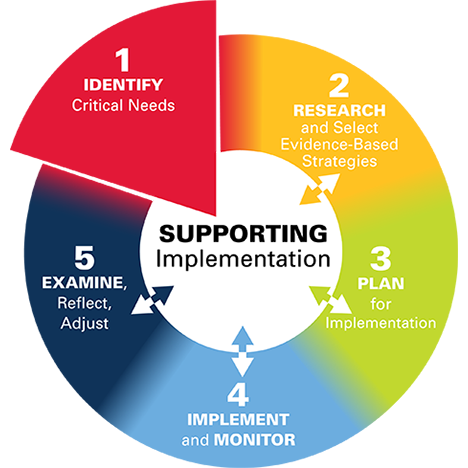Identify Critical Needs
In the cycle of continuous improvement, finding and selecting evidence-based strategies is not the first step.
The first step in planning for improvement is to Identify Critical Needs.
Why is this so important?
No matter how many positive evaluations have been carried out on a strategy, if that strategy is not designed or proven to meet the local needs that you have identified and prioritized, then it is not an evidence-based strategy for you.
Identifying critical needs means engaging in a deliberative, systematic and data-driven needs assessment process.
Intentional data collection, data analysis and team-based discussion about root causes, prioritization, and possible solutions encourages impartial, non-judgmental identification and decision-making about critical needs.
Organizations can carry out needs assessments in different ways. Common across these different approaches are three key areas of consideration:


Prepare Your Team
A needs assessment process is best thought of as a group effort. The exact make-up of the needs assessment team may vary by district. What is most important is that:
- Stakeholder interests are represented;
- Key district and building leadership, as well as data analysis roles are filled.
Questions to consider as you assemble your needs assessment team include:
- Stakeholders: Who are your key stakeholders? How will you learn more about what they see as your district or school’s needs and priorities? How will you share the results of your needs assessment with your stakeholders?
- Team Roles: Who are the key internal staff who will serve on your needs assessment team? Who will lead the team? Who will be responsible for data analysis? Who will lead discussion about root causes, prioritization and possible solutions?
- Time and Process: How will you ensure that your internal team has sufficient time to carry out a robust needs assessment? How will the team communicate with each other about progress on the needs assessment?
The Ohio Improvement Process encourages districts to leverage District Leadership Teams (DLTs), Building Leadership Teams (BLTs) and Teacher-Based Teams (TBTs) throughout the needs assessment process. Engaging each of these teams in the process at the appropriate times ensures alignment of efforts across classrooms, buildings and the district.

Data Collection and Analysis
When you look at your data and see a gap between your current state and your ideal state, you have identified a need.
What data should you review during your needs assessment process? There is no single answer to that question; best practice is to consider a wide range of student, adult, community and organizational data.
Different data sources give you a different lens with which to review a specific problem or need.
For example, you may come to understand more about your students’ academic performance if you look at it through the lens of educator equity. When you supplement data on chronic absenteeism rates with additional data on students’ perceptions of school climate, you may think differently about which evidence-based strategy will to help you keep kids in the classroom.
As you prepare for and carry out your needs assessment, some key questions to ask yourself about data analysis include;
- What data is available to inform the discussion and what additional data is needed? Who has access to this data?
- Will school- and district-level data be enough to help you understand your needs? How would looking at student subgroups or other disaggregations help you understand your needs?
- Does the data show gaps between target and current outcomes? Are those gaps greater for some student subgroups?
Examples of Possible Data to Inform Needs Assessments

Prioritization, Root Cause Analysis and Solutions
In the data analysis process, you may identify more than one need. Your next steps are to to identify – and communicate – the highest priority needs, carry out a root cause analysis to better understand why the need exists, and generate possible solutions As you carry out this work, consider the following questions:
- How does each need align with your stakeholder’s priorities?
- Who will facilitate your team’s discussion about prioritization? Will the team have all the contextual information they will need to be able to prioritize needs?
- Who will facilitate a root cause analysis discussion? What are the strategies your team will use to identify root causes (e.g., 5 Whys, Fishbone Analyses, affinity diagrams)?
Who will facilitate discussions around possible solutions? Who from your District Leadership Teams (DLTs), Building Leadership Teams (BLTs), Teacher-Based Teams (TBTs) and stakeholder groups can provide insight on solutions?
